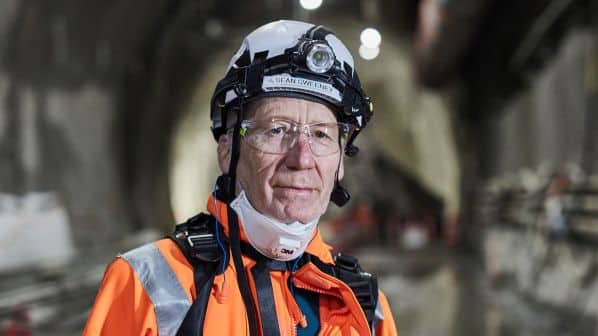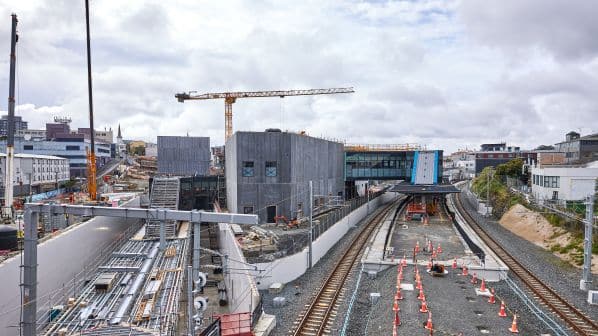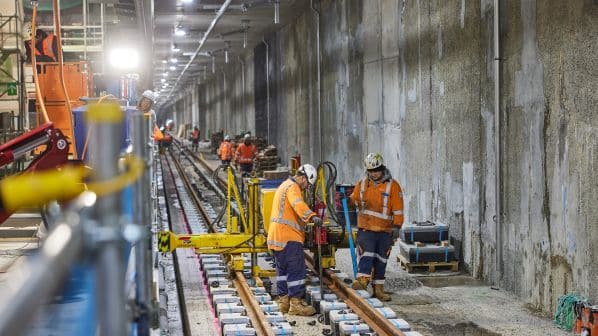FROM above, Auckland’s city centre appears hemmed in by roads. State Highway 1, which runs the length of New Zealand, cuts north-south through the heart of Auckland, while State Highway 16 runs east-west and coast to coast across the Tāmaki Isthmus that the city straddles. Just south of the city centre sits Spaghetti Junction, a “fiendishly complicated, multi-layered puzzle of concrete, steel and asphalt” built in the 1970s where the two motorways intersect.
Auckland’s reliance on cars skyrocketed in the late 20th century, which coupled with the removal of the city’s tram network in the 1950s and strong population growth led to growing congestion over the ensuing decades.
In response, transport investment was increased from around $NZ 500m ($US 294.1m) a year in 2000 to more than $NZ 2bn in 2015, used largely to complete the motorway network, upgrade and electrify the city’s rail network, and support construction of the Northern Busway.
But deep beneath the city is the biggest public transport project of them all. The City Rail Link (CRL) will connect the city centre’s Waitematā station, previously known as Britomart, with Mount Eden station on the Western Line, which is being rebuilt and renamed as Maungawhau, via two tunnels dug at up to 42m below the city centre. The CRL will transform Waitematā into a through station, more than doubling rail capacity across the city.
The project also includes two new stations, Te Waihorotiu and Karanga-a-Hape, which are currently under construction. When fully operational, the new line will carry up to 54,000 passengers per hour.
The project is being implemented by City Rail Link Ltd (CRLL), a crown entity created by the New Zealand government and Auckland Council to deliver the project.
The project met a major milestone on September 22, with the completion of tracklaying in the first of the two 3.45km-long tunnels. Civil works are largely complete, with work now underway on the architectural, mechanical and rail systems fit-out.
“The next big target date for us is the first train running in July next year,” says CRLL CEO, Dr Sean Sweeney. “It’ll be in some form of test running that will be very restricted, but the train running in the tunnel… is a target that the team has set themselves.”
Project challenges
But it hasn’t been an easy journey so far.
“This is the biggest project New Zealand has ever done, so that brings its own challenges because you’ve got a project far bigger than the industry is set up to deliver,” Sweeney says. “That’s been an ongoing challenge which the industry has responded to.”
There have also been multiple external challenges as well.
“We kicked off in a drought, and then in 2020, we had Covid right through to 2022. And this year we’ve had floods of biblical proportions. So we’re going through the biblical events, we’ve really only got famine and pestilence left before we’ve done the full circle, but these jobs run so long you do get exposed to things.”
The drought affecting Auckland at the start of the project led to severe restrictions on water use and, as big construction projects use a great deal of this precious resource, Sweeney says there were real concerns that the project would be seen as a waste of water. In response, the project invested heavily in water recycling technology to reduce its burden on the local supply.
The project also escaped two flooding emergencies in January with “minimal lasting impact” to the tunnels and underground stations. An unprecedented amount of heavy rain fell across the top of the North Island between January 27 and 28, followed shortly afterwards by Cyclone Gabrielle, which devastated some eastern parts of the country.
The project company said at the time that the worst-affected site was the cut-and-cover tunnel immediately south of the temporary entrance to Maungawhau station, which was partially flooded. As Cyclone Gabrielle approached, crews erected dams in the station tunnels and installed extra bunds and pumps as well as moving plant and machinery to higher ground.

The Covid-19 pandemic in particular proved to be a major challenge as New Zealand implemented one of the strictest lockdown and border closure regimes in the world, a major issue when the New Zealand construction sector relies on sourcing 20% of its workforce from overseas.
The project was also heavily impacted by the disruption of global supply chains, especially due to the country’s geographical location, with the major suppliers reconfiguring their supply chains to end in Australia. “They basically threw New Zealand off their supply chains, so everything that took three weeks to get to us suddenly took three months or more,” Sweeney says. The prolonged impact of Covid on Asia also continued to affect the project, with a large amount of the machinery required for the project stuck in Shanghai.
These factors inevitably resulted in a surge in construction costs by 25% within two years.
In March, CRLL announced that the cost of the project would rise to $NZ 5.49bn, a $NZ 1.07bn increase on the previous estimate of $NZ 4.42bn approved in May 2019. CRL also revised the project completion date, with construction of the stations and supporting rail infrastructure now expected to be completed by November 2025.
At the time, CRLL said the cost of construction supplies had increased by:
- reinforced concrete floor slabs, 13.4%
- D32mm rods, 13.8%
- fibre cement sheets, 10%, and
- steel cladding, 9.5%.
In addition, CRL says there were Covid impacts that were difficult to quantify but had a material effect on the project, including negative productivity and lost opportunity costs due to lockdown and illness, ongoing labour constraints, supply chain disruption and resource scarcity.
“It’s been relentless challenges,” Sweeney says. “Since the floods in January and February of this year we’ve had the most tranquil eight months that we’ve had on the project so it’s good to be able to get your head down and make a bit of progress.”
Link Alliance
Sweeney credits the project alliance contractual structure used to deliver the project, and the flexibility and openness of all partners involved, as one of the major factors that has allowed the project to continue despite these major challenges. “It is the collaborative form of contracting,” Sweeney explains.
The Link Alliance, which was awarded the major design and construction contract for the main 3.4km section in July 2019, is a joint venture between CRLL and a consortium of three designers and three construction companies:
- Vinci Construction Grands Projects (consortium leader)
- Downer NZ
- Soletanche Bachy International NZ
- WSP New Zealand
- Aecom New Zealand, and
- Tonkin+Taylor.
The Link Alliance was later awarded contracts for the construction of two grade-separated junctions and 2km of new track, to be constructed while keeping the North Auckland Line open to rail traffic, and the installation of the power supply, catenary, signalling and control systems for the entire CRL.
Under the alliance agreement, the contractors work with their profit at risk with CRLL guaranteeing it will cover the direct costs incurred. However, this contractual setup was stretched by the impact of the pandemic and the other challenges, which resulted in a significant risk of the contractors losing all profit from the project. “Builders can’t work on large jobs at no profit because they need the profit to keep their organisations running,” Sweeney says. “It’s fine that they’re not suffering direct costs losses but they need to cover the overheads as well.”
“Basically, we took the builder’s problems as being our problems, and the view that the project would be materially worse for the people of New Zealand if we didn’t address their problems..... we’ve rolled our sleeves up and said ‘OK, how are we going to fix this?’”
Dr Sean Sweeney, CRLL CEO
This led to a renegotiation of contract terms, a process that Sweeney says wasn’t always easy and at times required him and and former CRLL chairman, Sir Brian Roche, to travel to Paris to meet with Vinci’s parent company. However, he proudly points out that this did not ever mean threatening the project partners with legal action or holding them strictly to the terms of the contract.
“Projects get built by people and problems get solved by people, and I’m not meaning lawyers,” he says. “Basically, we took the builder’s problems as being our problems, and the view that the project would be materially worse for the people of New Zealand if we didn’t address their problems, which we’ve done and we’re very pleased about that. We didn’t just sit there and cite the contract to our builder, we’ve rolled our sleeves up and said ‘OK, how are we going to fix this?’”
The negotiations resulted in the price increase announced in March, but Sweeney says there was a “fair bit of rigour” in the final agreement that meant it was a fair deal for all parties involved, ending all claims and allowing construction to continue smoothly until completion.
“I suppose when we finished the negotiation, all parties felt equally dissatisfied, and that’s probably the sign of a good deal, when everyone feels that they’ve been a little bit done over,” he says. “No one’s running away going ‘we’ve cracked it’ and opening the champagne. But we all realised it was a deal that we could all live with, and therefore it was a deal that would stick.”
Systems integration
The project is now entering what could be the most complicated stage yet: systems integration. But here CRLL is learning from another, much bigger project: the Crossrail project to build what is now known as the Elizabeth Line under central London.
“The [CRL] project was originally modelled around Crossrail, because when the project was set up Crossrail was viewed as a model project and then the wheels fell off it,” Sweeney says. “So we studied Crossrail a lot, what to do right and also what not to do.”
This included hosting former Crossrail chief executive, Mr Mark Wild, who visited Australia and New Zealand to talk about the lessons learned during the implementation of the project. “He was searingly honest about what they did well, and what they didn’t do well,” Sweeney says.
Wild’s most important message, one which Sweeney says CRLL has taken fully onboard, was that systems integration is a process that the client has to take ownership of, instead of contracting it out to the construction company or technology supplier.Martinus NZ is responsible for tracklaying on CRL, while Siemens Mobility has been awarded a contract to supply and install its Computer-Based Interlocking (CBI) Westrace MKII ETCS signaling system. Siemens is responsible for the engineering and design of the signaling system, and the supply of materials such as signals, SER single-insulator medium-voltage disconnects, balises, fully equipped signal equipment rooms, and trackside locations cases.
Sweeney says the signalling systems have been manufactured and tested in a factory setting, and CRLL is in the process of testing them in an off-site integration facility, before they are then installed on the project itself, where they will be tested again. On-site testing and commissioning is expected to begin around the end of 2023 and is due to take around a year and a half but Sweeney says that based on the experience of Crossrail and other similar projects, “no one quite knows how that will go.”
“We have to be ready to expect the unexpected,” he says.
CRL does lack much of the complexity of the Crossrail project, which integrated three different signalling systems and aimed to provide “ambitious” levels of train control. Instead, CRL will be equipped with ETCS Level 1 to match the system already installed across the Auckland network.
CRLL is also learning from Crossrail’s mistake of announcing deadlines it couldn’t keep, and as such Sweeney is reluctant to give an opening date for CRL, which he says is up to the operator, Auckland Transport, to set.

“We have said to our sponsors, ‘we are going to deliver this railway at the end of November 2025, and you need to then work out when your day one of operations will be,’” he says. “The public want to know a date, [but] they don’t need to know a date. I think Crossrail eventually gave six weeks’ notice before they went live. We’ve said very strongly to Auckland Transport ‘you should follow suit.’”
As well as learning from Crossrail, CRLL has also been in constant communication with similar projects in Australia, including the Sydney Metro, Melbourne Metro and Brisbane’s Cross River Rail.
“The Sydney and Melbourne projects are 18 months ahead of us, so we can talk to them about lessons learned,” Sweeney says. “Cross River Rail is basically matching us so we have different learning from them. We’re both just starting a systems integration task, and we are swapping notes about what’s troubling us at the moment.”
However, the large number of projects currently underway across the Tasman Sea in Australia contrasts with the lack of future projects in New Zealand and is contributing to a shortage of experienced staff. “Unfortunately all our tunnellers have gone back overseas because there’s no other job for them to do here,” Sweeney says. “Generally they go to Australia and then we have to fight to get them back here.”
Network integration
Sweeny says that when he joined CRLL in 2018, there were suggestions that construction of CRL should be paused to allow it to better integrate with the proposed Auckland light rail line, but he was not convinced. This approach of focusing on getting CRL done has paid off.
Five years later, as CRL is nearing completion, the light rail project remains at the business proposal stage. The newly-elected government led by the National Party campaigned on a pledge to scrap it entirely in favour of four road and three bus projects, in place of the partially-underground 24km light rail route proposed by the previous Labour-led administration.
Even without the light rail project, there is $NZ 7bn of network integration work required across Auckland’s commuter rail network to realise the full capacity benefits of CRL over the coming 10 to 15 years.
“Generally governments will spend money when they need to, and at the moment, there’s no pressing need to do all of those upgrades today, but to fully operationalise the city rail link you need to do that work,” Sweeney says.
How quickly this money is spent and these improvements are implemented is up to the politicians to decide. However, the opening of CRL itself sometime after November 2025 will go a long way to reducing the reliance on road in the city of sails.

